Francesco Cossiga facts for kids
Quick facts for kids
Francesco Cossiga
|
|
|---|---|
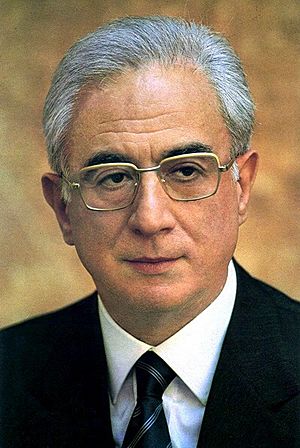 |
|
| President of Italy | |
| In office 3 July 1985 – 28 April 1992 Acting: 29 June 1985 – 3 July 1985 |
|
| Prime Minister | Bettino Craxi Amintore Fanfani Giovanni Goria Ciriaco De Mita Giulio Andreotti |
| Preceded by | Sandro Pertini |
| Succeeded by | Oscar Luigi Scalfaro |
| President of the Senate of the Republic | |
| In office 12 July 1983 – 3 July 1985 |
|
| Preceded by | Vittorino Colombo |
| Succeeded by | Amintore Fanfani |
| Prime Minister of Italy | |
| In office 5 August 1979 – 18 October 1980 |
|
| President | Sandro Pertini |
| Preceded by | Giulio Andreotti |
| Succeeded by | Arnaldo Forlani |
| Minister of the Interior | |
| In office 12 February 1976 – 11 May 1978 |
|
| Prime Minister | Aldo Moro Giulio Andreotti |
| Preceded by | Luigi Gui |
| Succeeded by | Virginio Rognoni |
| Minister for Public Administration | |
| In office 23 November 1974 – 12 February 1976 |
|
| Prime Minister | Aldo Moro |
| Preceded by | Luigi Gui |
| Succeeded by | Tommaso Morlino |
| Member of the Senate of the Republic | |
| In office 28 April 1992 – 17 August 2010 For life |
|
| Status | Ex officio |
| In office 12 July 1983 – 3 July 1985 |
|
| Constituency | Sardinia |
| Member of the Chamber of Deputies | |
| In office 12 June 1958 – 11 July 1983 |
|
| Constituency | Cagliari–Sassari |
| Personal details | |
| Born |
Francesco Maurizio Cossiga
26 July 1928 Sassari, Kingdom of Italy |
| Died | 17 August 2010 (aged 82) Rome, Italy |
| Political party | DC (1945–1992) UDR (1998–1999) UpR (1999–2001) Independent (2001–2010) |
| Height | 1.77 m (5 ft 10 in) |
| Spouse |
Giuseppa Sigurani
(m. 1960; div. 1998) |
| Children | 2, including Giuseppe |
| Alma mater | University of Sassari |
| Occupation | Politician |
| Signature |  |
Francesco Maurizio Cossiga (born 26 July 1928 – died 17 August 2010) was an important Italian politician. He was a member of the Christian Democratic Party. He served as the Prime Minister of Italy from 1979 to 1980. Later, he became the President of Italy from 1985 to 1992. Many people consider Cossiga one of the most important politicians of Italy's First Republic.
Cossiga also worked as a minister in different government roles. He was especially known as the Italian Minister of the Interior. In this job, he reorganized Italy's police force, civil protection, and secret services. He was known for being very strict about public order. He was the Minister of the Interior when Aldo Moro was kidnapped and killed in 1978. Cossiga resigned from his role after Moro's death. He was also Prime Minister during the Bologna station bombing in 1980.
Before becoming a politician, Cossiga was a professor. He taught constitutional law at the University of Sassari.
Contents
Early Life and Education
Francesco Cossiga was born in Sassari, Italy, on 26 July 1928. His family was middle-class and against fascism. He was related to Enrico Berlinguer, another famous Italian politician.
Cossiga was very smart. He finished high school at age sixteen, three years earlier than usual. At nineteen, he earned a law degree. He then started teaching constitutional law at the University of Sassari. While at university, he joined the Italian Catholic Federation of University Students (FUCI). He became the leader of this group in Sassari.
Beginning of His Political Journey
Cossiga was first elected to the Chamber of Deputies in 1958. This was Italy's lower house of Parliament. He represented the area of Cagliari–Sassari.
In 1966, he became the youngest Undersecretary of the Ministry of Defence. This was during the government of Aldo Moro. In this role, he had to deal with the aftermath of a planned plot for a government takeover.
From 1974 to 1976, Cossiga served as the Minister of Public Administration. This was also in a government led by Aldo Moro.
Minister of the Interior
On 12 February 1976, Francesco Cossiga became the Italian Minister of the Interior. This role is in charge of public safety and security. During his time as minister, he reorganized the Italian police, civil protection, and secret services. Cossiga was known for being very firm in dealing with public protests.
Protests and Unrest in 1977
In 1977, there were many violent street clashes in the city of Bologna. On 11 March, a student named Francesco Lorusso was killed during a protest. This led to more clashes with the police for two days.
Cossiga sent armored vehicles into the university area to stop the unrest. These clashes caused many injuries and some deaths among people caught in the riots.
Other cities like Turin and Rome also saw violent events. In Rome, a young woman named Giorgiana Masi was killed during a protest. The people responsible for her death were never found.
The Kidnapping of Aldo Moro
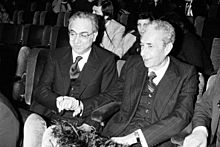
Cossiga was the Minister of the Interior when Aldo Moro was kidnapped. Moro was a very important Christian Democratic leader. He was kidnapped by a terrorist group called the Red Brigades. This happened on 16 March 1978, in Rome. The terrorists killed Moro's bodyguards and took him away.
Cossiga quickly set up two special groups to handle the crisis. These groups included leaders from the police and intelligence services. A third unofficial group of experts was also formed.
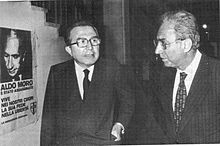
After 55 days, on 9 May 1978, Aldo Moro's body was found. He had been killed by the Red Brigades. Two days later, Cossiga resigned from his position as Minister of the Interior.
Prime Minister of Italy
One year after Aldo Moro's death, Francesco Cossiga became the Prime Minister of Italy. He led a government made up of several political parties.
The Bologna Station Bombing
Cossiga was the head of the government during the Bologna massacre. This was a terrible terrorist bombing at the Bologna Central Station. It happened on 2 August 1980. The attack killed 85 people and injured more than 200.
At first, Cossiga thought the explosion was an accident. But soon, it became clear it was a terrorist attack. The attack was later blamed on a neo-fascist group. However, Cossiga later suggested other theories, including involvement of Palestinian groups. He also said he believed the neo-fascists accused of the attack were innocent.
Resignation as Prime Minister
In October 1980, Cossiga resigned as Prime Minister. This happened after the Italian Parliament rejected the government's budget plan.
After the 1983 general election, Cossiga became a member of the Italian Senate. On 12 July, he was elected President of the Senate.
President of Italy
In 1985, Francesco Cossiga was elected President of Italy. He won with a large number of votes. This was the first time an Italian presidential candidate won on the first vote. He officially took office on 3 July 1985.
For the first five years, Cossiga acted as president in a traditional way. He focused on making sure the government followed the Constitution. The President of Italy acts as a neutral guide between the different parts of the government.
"The Pickaxe-Wielder" President
In his last two years as president, Cossiga started to express very strong and unusual opinions. He believed that Italian political parties needed to change. This was because the Berlin Wall had fallen and the Cold War had ended. He thought these events had deeply changed the world.
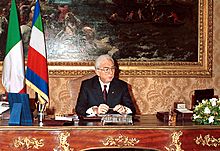
Cossiga's statements were often provocative and caused a lot of debate. People called them "picconate" or "pickaxe blows." Many thought these statements were not appropriate for a president. Cossiga famously said, "I am the fake madman who speaks the truth."
He also spoke about his concerns regarding the Italian justice system. He felt that young judges were immediately sent to work on mafia cases.
Because of his new style, Cossiga received criticism from almost all political parties. However, the Italian Social Movement supported him. He was seen as one of the first to accept this party as a normal, democratic force.
Gladio Revelation and Resignation
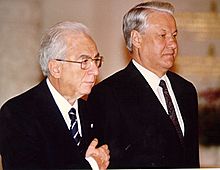
There was some tension between Cossiga and Prime Minister Giulio Andreotti. This happened when Andreotti revealed the existence of Gladio. Gladio was a secret organization. Its goal was to fight a possible Soviet invasion of Italy. Cossiga admitted he was involved in setting up this group.
Some politicians tried to start an impeachment process against Cossiga. This is a process to remove a president from office. However, the request was eventually dismissed.
Cossiga resigned from his presidency two months before his term was supposed to end, on 25 April 1992. In his final speech, he told young people to "love the fatherland, to honor the nation, to serve the Republic, to believe in freedom and to believe in our country."
After the Presidency
According to the Italian Constitution, former presidents become Lifetime Senators. This means they can continue to serve in the upper house of Parliament.
In 1998, Cossiga created a new political party called the Democratic Union for the Republic (UDR). This party helped form a new government in 1998. Cossiga said his support for this government was to allow former communist leaders to become prime minister in Italy.
In 2006, Cossiga supported the formation of another government. He also proposed a law that would allow the region of South Tyrol to vote on whether to stay in Italy, become independent, or join Austria.
On 27 November 2006, he resigned from his position as a lifetime senator. However, the Senate rejected his resignation. In 2008, Cossiga voted in favor of the government led by Silvio Berlusconi.
Death and Legacy
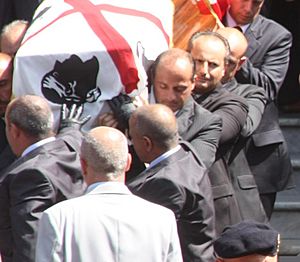
Francesco Cossiga passed away on 17 August 2010. He died from breathing problems in a hospital in Rome. After his death, four letters he had written were sent to Italy's top government leaders.
His funeral was held in his hometown of Sassari. Cossiga is buried in the public cemetery of Sassari, near another former President of Italy, Antonio Segni.
In 2020, Cossiga was shown in the film Rose Island.
Images for kids
See also
 In Spanish: Francesco Cossiga para niños
In Spanish: Francesco Cossiga para niños




